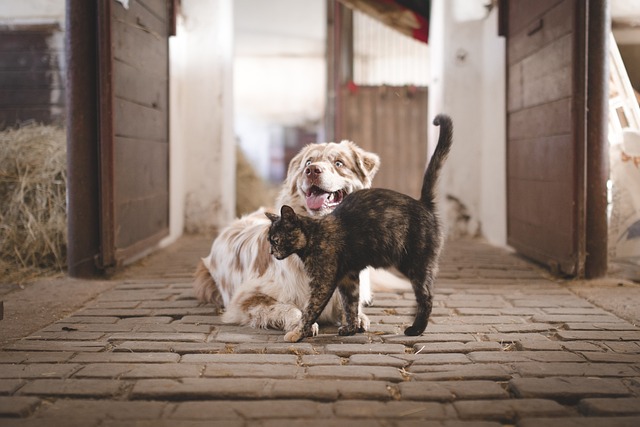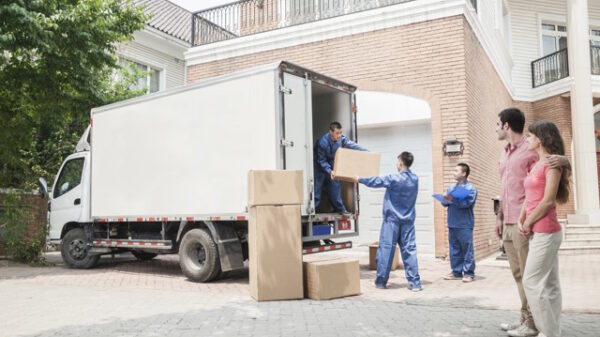There are so many things to think about when moving house that it’s easy to overlook the wellbeing of your furry friends.
Upping sticks and moving to a new home can be stressful for your cat or dog so you to make them as comfortable as possible.
However, with proper planning and preparation, moving house with a pet can be a smooth and stress-free transition.
Here are some tips on how to move with a cat or dog to ensure your pets are well looked after and happy in their new home.
Moving house with a cat
The first step when planning to move house with a cat is to prepare them for what’s to come.
This includes gradually introducing them to the carrier or crate that they will be travelling in.
You can start by placing the carrier in a quiet area of the house, and encouraging your cat to investigate it.
It’s a good idea to place treats and toys inside the carrier to create a positive association.
Once your cat is comfortable with the carrier, it might be an idea to take them for a couple of short drives to get them used to the motion of the car.
When it comes to the day of the move, it is a good idea to keep your cat in a separate room where there’ll be minimal noise and disruption with their carrier, food, water, litter box, and toys.
Whatever you do, don’t let them out!
There’s nothing worse than not being able to find your cat as you’re about to leave your home for good.
Cats are easily scared, and the disruption caused by the removal team could cause them to run off and hide.
Make sure to check on them regularly and provide them with plenty of attention and affection, while keeping the doors and windows closed in the room they’re in.
During the actual move itself, it’s essential to ensure your cat is safe and comfortable.
Keep the carrier securely fastened in the car with a seat belt, and make sure your cat has access to water and a comfortable blanket or towel to lie on.
There are pheromone sprays and collars on the market which are designed to reduce your cat’s stress levels so you might want to consider using one.
If possible, have someone who the cat is familiar with sitting next to them so they can soothe the cat during the journey.
Settling in your cat to your new home
Once you arrive at your new home, set up a designated area for your cat that includes their litter box, food, water, and familiar toys.
Allow your cat to explore the new surroundings at their own pace, and provide them with plenty of attention and affection to help them feel comfortable.
How to settle a cat into a new home – tips and tricks:
1. Keep them confined to one room
When you first move into your new home, keep your cat confined to one room, such as a bedroom or a bathroom.
This will help them feel safe and secure in their new environment.
Make sure the room has all the essentials your cat needs, such as a litter box, food and water dishes, toys, and a comfortable bed.
2. Gradually introduce them to the rest of the house
After your cat has had some time to adjust to their new surroundings, gradually introduce them to the rest of the house.
Start by opening the door to their room and allowing them to explore the adjacent room.
Over time, you can open more doors and allow them to explore more areas of the house.
3. Keep their routine consistent
Cats thrive on routine, so it’s important to keep their daily routine as consistent as possible during the move.
Stick to their regular feeding, playing, and sleeping schedule to help them feel more comfortable and secure.
4. Provide them with plenty of hiding spots
Cats like to have their own space to hide and feel safe.
Provide your cat with plenty of hiding spots throughout the house, such as cardboard boxes or cat trees.
This will help them feel more comfortable in their new environment.
5. Use familiar scents
Cats rely heavily on their sense of smell to navigate their environment.
To help your cat feel more comfortable in their new home, use familiar scents such as their bedding, toys, or blankets from their previous home.
This will help them feel more secure in their new surroundings.
6. Give them plenty of love and attention
Moving can be stressful for cats, so it’s important to give them plenty of love and attention during this time.
Spend time with your cat, play with them, and give them plenty of affection to help them feel happy and secure in their new home.
7. Give your cat time to adjust
Remember, cats are creatures of habit, and it may take some time for them to adjust to their new surroundings.
Be patient and kind to your furry friend, and they will soon feel at home in their new environment.
How long should I keep a cat indoors when moving?
It’s important to keep your cat indoors when you move otherwise there’s a risk they could get lost.
The RSPCA recommends that you give your cat at least two weeks to settle in before allowing them to roam outside.
Even then, you should make sure that your cat’s behaviour has settled before doing so as some cats may take longer to adjust to their new environment than others.
Be patient with your cat and give them plenty of time and space to settle in.
You may also want to consider gradually introducing them to new rooms in the house to help them feel more comfortable.
Should I put butter on my cars paws when I move house?
It used to be thought that if you put butter on your cats paws it’ll help them create a scent when exploring a new area and take away the smell of your old home.
This is now known to be untrue and may actually create new problems.
The scent of your old home will remain on their fur and the cat may become stressed trying to rid its paws of the butter and the associated smell.
While it’s important to ensure your cat is properly adjusted before allowing them outside, some cats settle in much faster than others.
I’ve had a cat who managed to escape after two days in a new property and he was absolutely fine, returning for his dinner at the same time he would in the old house.
There was virtually no adjustment period and he quickly established a routine and his territory.
Planning your move with a cat
As you can see, moving house with a cat requires careful planning and preparation.
By gradually introducing your cat to their carrier and providing them with a safe and comfortable environment during the move, you can help reduce their stress levels and ensure a smooth transition to their new home.
Remember to be patient with your cat and give them plenty of attention and affection to help them feel comfortable and secure in their new surroundings.
Moving house with a dog
Moving house with a dog can be just as stressful as with a cat, as dogs also thrive on routine and familiarity.
It’s important to take steps to ensure their comfort and safety during the move.
So here are some tips on how to move house with a dog:
Prepare your dog for the move
Dogs can sense when something is changing, so it is important to prepare them for the move as early as possible.
As with cats, start by gradually introducing your dog to their travel crate or carrier and associate it with positive experiences, such as feeding or playing.
This will help your dog feel more comfortable and relaxed during the move.
Keep your dog away from the chaos
Moving can be chaotic and stressful, so it is best to keep your dog away from the commotion on moving day.
Set up a quiet and comfortable space for your dog away from the movers, such as a bedroom or a crate.
Make sure to provide them with water, food, and a comfortable bed.
If you hire a home removals company, it’s a good idea to keep the movers away from your dog as he or she may feel threatened by the upheaval and react badly to strangers.
Update their identification
Before moving, make sure to update your dog’s identification tags and microchip with your new address and contact information.
This is important in case your dog gets lost or runs away during the move.
It’s harder to keep a dog indoors than it is a cat as most dogs require walking and exercise.
Stick to your dog’s routine
Dogs thrive on routine, so it is important to keep their daily routine as consistent as possible during the move.
Stick to their regular feeding, exercise, and sleeping schedule to help them feel more comfortable and secure.
Make the car ride comfortable
If you are moving a long distance, make sure to prepare your dog for the car ride.
Most dogs will be used to riding in cars when they’ve been on walks/holidays but it might be worthwhile doing a couple of journeys in the run up to the move.
On move day, make sure to provide them with plenty of water, treats, and toys during the journey.
Consider using a dog seat belt or crate to keep your dog safe and secure in the car.
Tips and tricks to settling a dog into a new home
Once you arrive at your new home, make sure to help your dog adjust to their new surroundings as it will be an unsettling time for them.
Set up a familiar space with their bed, toys, and food and water bowls in the house and take them for regular walks around the neighbourhood to help them get used to the new sights and smells.
It’s important to be patient with your dog as it may take some time for them to adjust to their new surroundings and routine.
You’ll play a key role in making them feel secure and ensuring they’re not giving the opportunity to run off.
Follow these tips and tricks to make moving with your dog go as smoothly as possible:
1. Keep them on a leash
When you first move into your new home, keep your dog on a leash to help them explore their new surroundings safely.
This will help them feel more secure and prevent them from getting into any potential danger.
2. Create a safe space
Designate a specific area in your new home as a safe space for your dog. This could be a crate, a room, or a corner of a room.
Make sure the space has all the essentials your dog needs, such as food and water bowls, a comfortable bed, and toys.
3. Stick to their routine
Dogs thrive on routine, so it’s important to keep their daily routine as consistent as possible during the move.
Stick to their regular feeding, playing, and sleeping schedule to help them feel more comfortable and secure.
4. Introduce them to the neighbourhood
Take your dog for walks around the neighbourhood to help them get familiar with their new surroundings.
This will also help them become more comfortable with the sights and sounds of their new environment.
5. Use familiar scents
Dogs rely heavily on their sense of smell to navigate their environment.
To help your dog feel more comfortable in their new home, use familiar scents such as their bedding, toys, or blankets from their previous home.
This will help them feel more secure in their new surroundings.
6. Give them plenty of love and attention
Moving can be stressful for dogs, so it’s important to give them plenty of love and attention during this time.
Spend time with your dog, play with them, and give them plenty of affection.
This will help them feel more comfortable and secure in their new home.
Kindness is key
Following these tips will help your dog adjust to their new home and reduce their stress levels.
Remember, dogs are social creatures, and they need plenty of love and attention from their owners.
Be patient and kind to your furry friend, and they will soon feel at home in their new environment.
Register your pet with a vet as soon as you’ve moved
It’s important that you register with a local vet as soon as you’ve moved to ensure their regular treatment continues uninterrupted and that you’re prepared for any emergencies.
Remember to update their microchip data to reflect your new address and contact details.
Conclusion
Moving house with a pet requires some extra planning and preparation.
Remember, pets rely on their owners for love and care, especially during times of change.
Be patient and kind to your furry friend, and you’ll both be enjoying your new home in no time.











